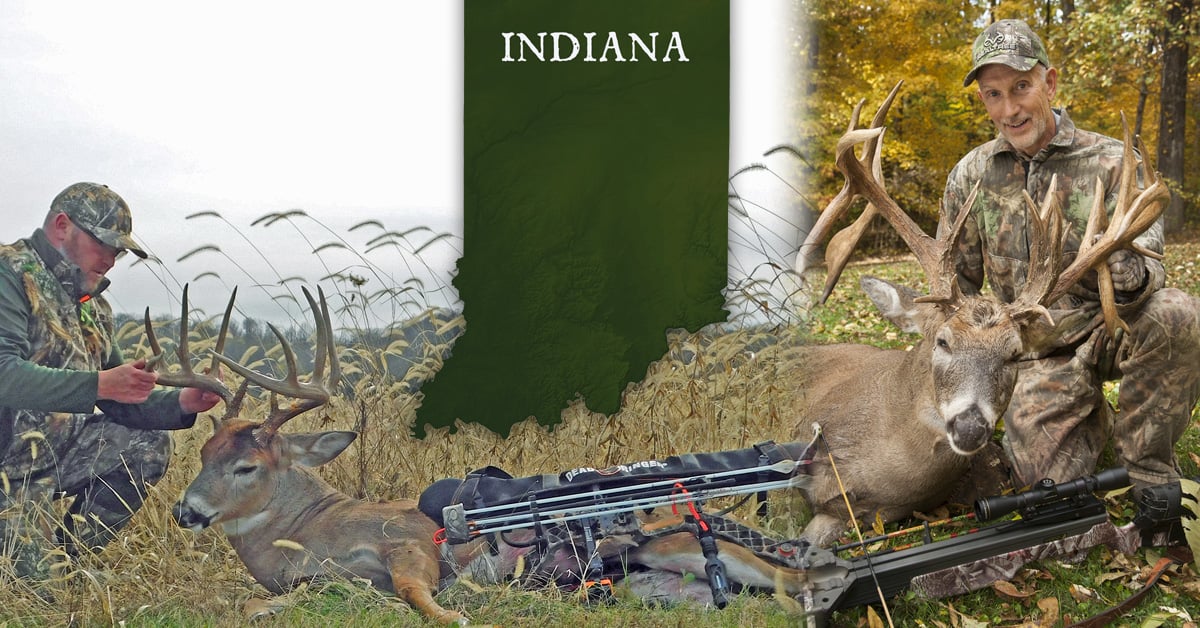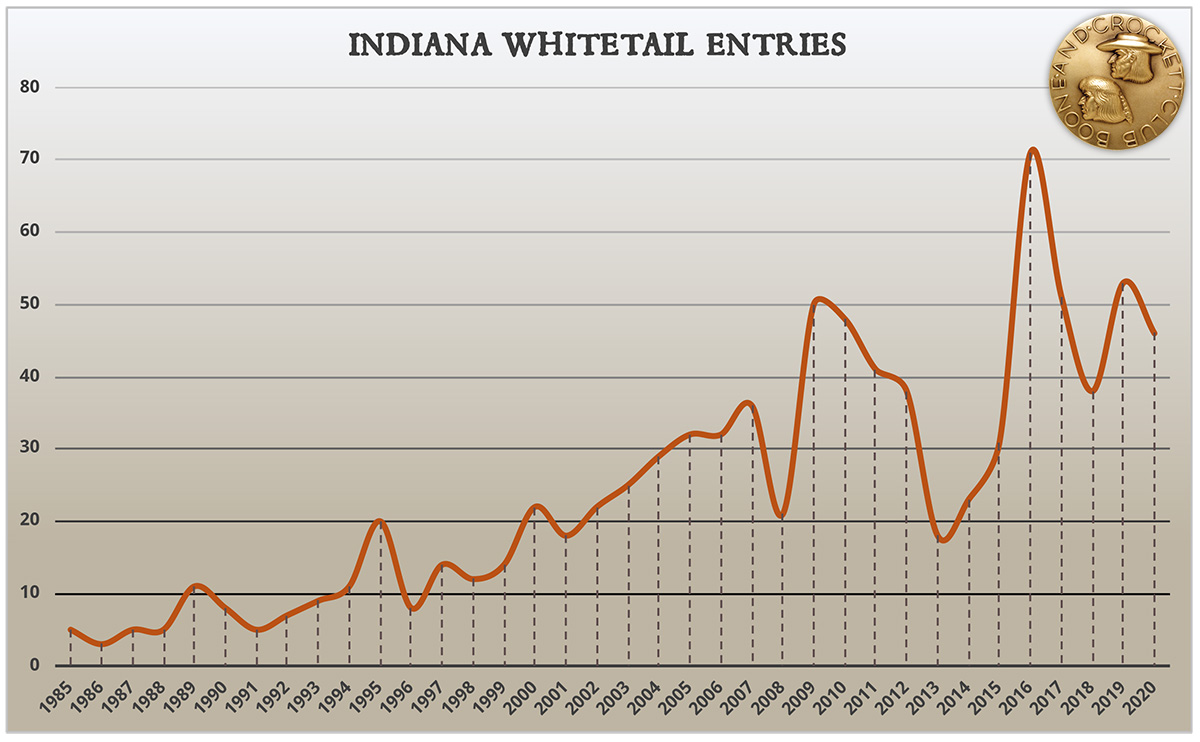Stewardship
Where Hunting Happens, Conservation Happens™
Indiana’s Big Whitetail Buck Revival
In the near future, we will be hearing more about record-book whitetails coming out of Indiana. Have hunters and wildlife managers there found a sweet spot for the state’s herd?
By PJ DelHommeIn case you missed it, a 27-year-old Indiana hunter named Dustin Huff recently shot the third biggest typical whitetail ever recorded. Indiana, it seems, has been on a hot streak the past couple of years in terms of Boone and Crockett entries. In fact, Indiana bucks have taken the top spot for number of record-book whitetail entries from 2019 and 2020. More on that in a bit. But first, what’s going on?
The One-buck Rule
Indiana has what’s called the “one-buck rule.” Like it sounds, it limits hunters to taking only one buck each season. And it’s been a game-changer—in terms of herd health, hunter satisfaction and trophy buck entries.
Prior to 2002, hunters could harvest at least two bucks, and this didn’t allow many bucks to get old. Most hunters would first shoot a very young meat buck, and then they would hunt a mature, trophy buck for their second tag, said Joe Caudell, state deer biologist with Indiana Department of Natural Resources (DNR). Caudell’s predecessor, Chad Stewart, explained in an article that in 2001, 56 percent of the bucks harvested were yearlings. Biologists were hearing from hunters that they wanted to see bigger bucks. As a result, the state implemented the one-buck rule as a temporary measure in 2002. The state then extended it in 2007. Then another request came to the DNR; this time it was from state legislators.
In 2010, the deer herd had reached social carrying capacity. Lawmakers began hearing from voters about rising vehicle collisions and crop depredation. The DNR authorized liberal doe seasons, and the plan worked. Not only did hunters knock down deer numbers, it also normalized killing does, which had been somewhat taboo as many older hunters remembered a time with relatively few deer running around the state.
Today, with the one-buck rule, hunters will typically shoot a doe to fill the freezer and then hold out for a trophy buck, passing up the younger ones, said Caudell. Around 70 percent of Indiana hunters shoot one deer, with around 21 percent shooting two deer. Not everyone kills a doe and a monster buck, but Caudell has found that this kind of management has created a healthier herd because there is a more varied age structure with the bucks. “Before the tag change, deer just couldn’t get old,” he said.
Using the Records
Caudell is quite familiar with the Boone and Crockett records. In fact, he became an Official Measurer in 2019. When he produces the state's annual deer report, he uses the Boone and Crockett records, specifically the County Search Tool, to research trends in the state’s deer entries. “If you look at the records from year-to-year, Indiana has been the top Boone and Crockett bucks producer in 2019 and ‘20,” he says. “The upward trend is really noticeable year-by-year.” As of this writing, record entries for the 2021 season are still being entered.
Consider this. From 1980-2002, Indiana hunters entered 209 Boone and Crockett whitetails into the records. From 2003-2020, after the one-buck rule was implemented, hunters there entered 683 B&C bucks. That’s nearly 500 more bucks entered in a shorter time span.
This kind of info is helpful to Caudell and the state because it’s one piece in the wildlife management puzzle. Another big driver in management is hunter satisfaction. “It really is the attitude of the hunters that is driving this change and increase in antler size,” Caudell said. “Our surveys indicate that 45-50 percent of our hunters say body size and antlers are important to them. That’s what they want.”
Using the Boone and Crockett records is one way Caudell is able to show the public that the DNR is giving them what they want. Without those records, it would be harder to measure successful management. “I have to put a plug in here for hunters to have their deer recorded,” he said. “One of the early intents of the records program was to inform biologists and others working in management. These records are just another data point in time, and that’s what biologists like—data over time.”
As for the Huff Buck
Did active deer management play a part in producing Indiana's biggest typical whitetail? “Oh yeah,” says Dustin Huff, the hunter who killed that 205-6/8 typical whitetail. “The one-buck rule in Indiana has really opened things up. We’re no longer a sleeper state. People are passing up the younger bucks.”
Caudell is going to be the last person to take any credit for the Huff Buck. Because Indiana is 95 percent private land, there is little wildlife managers can do to manipulate the actual landscape. “I’m going to give credit to the hunters and landowners who want bigger deer, or whatever their goals might be,” Caudell said. “We put a general framework in place for deer management, but it’s the landowner or a group of hunters that becomes educated on how they want to achieve that goal.”
As to the future of Indiana’s deer, time will tell if they continue to stand their ground with other whitetail powerhouses like Wisconsin and Illinois. In the meantime, Caudell will keep crunching the data to keep deer herds healthy and hunters happy.
Read about Dustin Huff's Buck...
Also view Indiana's State Big Game Records...
The Importance of Records in Big Game Management
When you enter your trophy into the Boone and Crockett system, you aren’t just honoring the animal and its habitat. You are participating in a data collection system that started in the 1920s and was refined by Club members in 1950. Today, there are nearly 60,000 trophy records. By establishing a records database more than 70 years ago, the Boone and Crockett Club established a scientific baseline from which researchers can use to study wildlife management. If you’re still on the fence about entering your trophy, we encourage you to read Why Should I Bother to Enter My Trophy. To the best of our ability, we ensure that the trophies entered into the records were taken in accordance with the tenets of fair chase ethics. Despite what some may think, the Boone and Crockett records are not about a name or a score in a book—because in the end, there’s so much more to the score.
Support Conservation
Support Hunting
Support Conservation
Support Education
"The wildlife and its habitat cannot speak. So we must and we will."
-Theodore Roosevelt






